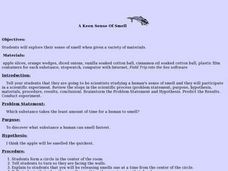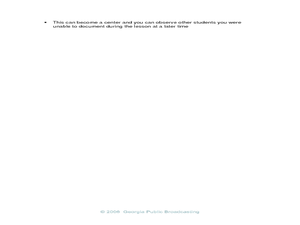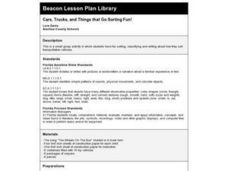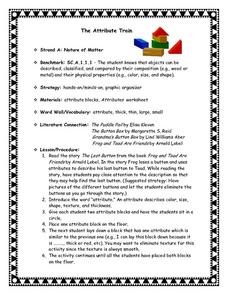Curated OER
Fronts
Fourth graders define cold and warm fronts, explain how they are formed and they ways that they affect the weather.
Curated OER
Cold Fronts And Warm Fronts
Students simulate the movement of cold and warm fronts as they listen to a story about the weather and Mr. Sun. They brainstorm the characteristics of each type of front then write about which front they would prefer if they were a...
Curated OER
A Keen Sense of Smell
Students investigate their sense of smell by experimenting with smelly objects. In this human senses lesson, students examine the length of time it takes to smell a random object that is close to them. Students record the different...
Curated OER
The Right Angle
In this geometry activity, 10th graders determine the answer to a vocabulary questions and then follow the give rules to place the answer in the appropriate place on the crossword grid. The one page activity contains 18 questions. ...
Curated OER
Areas of Polygons
Students calculate the are of regular polygons. In this geometry instructional activity, students create polygons on the computer and move it around to create different shapes. They explore the area of different polygons and how they...
Curated OER
Shape Detectives
Students become "shape detectives" as they identify, name, create and describe common shapes within pictures and objects found within the learning environment. Suggestions include incorporating shapes into all learning areas and daily...
Curated OER
Chemical Reactions
In this chemical reactions worksheet, students determine if solutions are acidic, basic, or neutral. Students give reactions' molecular equations and ionic equations. This worksheet has 14 problems to solve.
Curated OER
Sorting Gourds
Students discover different types of gourds. In this plant comparison lesson, students compare and contrast several types of gourds based on shape, color and texture. Students observe a video clip based on sorting gourds.
Curated OER
Lines, Segments, and Rays
Fifth graders use their arm, toothpicks, and marshmallows to create lines, segments, and rays. In this lines, segments, and rays lesson plan, 5th graders learn how these appear on a plane.
Curated OER
Scale Factor- Surface Area and Volume
Young scholars calculate the surface area and volume of shapes. In this geometry lesson plan, students create different scales and calculate the volume and area for each shape. They compare and contrast between the different scales and...
Curated OER
What's the Texture?
Learners sort, classify, and write about how they sort a variety of shells.
Curated OER
Cars, Trucks, and Things that Go Sorting Fun!
First graders sort toys by various attributes. They, in groups, sort toy vehicles by color, size etc. and then explain how they chose to group the toys. They write, draw or dictate an explanation of their sorting methods.
Curated OER
"Movement Qualities" Dance Lesson Plan
Students examine how dance steps can be done with different qualities. students perform their dance movement pattern with their choice of movement qualities.
Curated OER
Gummy Bear Sorting
Students demonstrate knowledge of sorting and classifying by color as they sort gummy bear candies.
Curated OER
Thunderstorms
Fourth graders investigate the attraction between two different charges to explain the concept of lightning in a thunderstorm.
Curated OER
LESSON 3: The Many Shades of Our World
Students recognize that people have many different types of skin color.
Curated OER
Dealing With Bullies
Students identify bullying behaviors and identify strategies for dealing with bullies. They participate in role-plays and discuss the experience later as a group. After role-playing scenarios provided by the teacher, students create...
Curated OER
Using Charts and Graphs to Study East Asia's Modern Economy
Students examine East Asia's modern economy. In groups, classmates use the internet to compare the resources, products, and economy of specified countries. After collecting the data, pupils create charts, tables and graphs. They...
Curated OER
Periodic Poetry
Young scholars review periodic table of elements, choose one element, and create piece of poetry about it using Cinquain, Haiku, or Acrostic format. Students then read aloud their poems to classmates.
Curated OER
Classification of Minerals
Students identify a specific mineral using Moh's Scale of Hardness. They also conduct research about the mineral looking for factors such as value, abundance ,location, and current uses. The instructional activity integrates technology...
Curated OER
It's a 3-D World Out There!
Students construct polygons. They identify attributes of three-dimensional shapes. Students name common three-dimensional shapes. They draw three-dimensional shapes, and sort three-dimensional shapes. Students use K'NEX materials sets to...
Curated OER
The Attribute Train
Students participate in a hands-on activity working with attribute blocks. After reading a story about attributes as a class, they each are given two attribute blocks. The first student lays one attribute block on the floor with the next...
Curated OER
Pyramids & Prisms: Guler's Formula
Sixth graders compare and contrast two-dimensional shapes to three-dimensional shapes. After watching a demonstration, they make their own shapes using nets printed on paper. To end the activity, they use the shapes they made and...

























